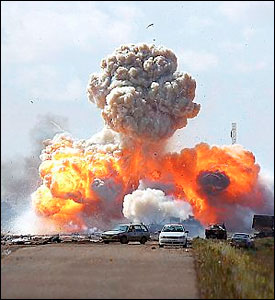21 March 2011 - ICBUW
ICBUW is concerned that the current use of US Marine Corps AV-8B Harrier ground attack aircraft could lead to DU contamination should their cannon be deployed against ground targets. ICBUW is also concerned that the potential for contamination may increase significantly as the conflict develops if US Air Force A-10 Thunderbolt ground attack aircraft are deployed.
The majority of platforms that fire DU are land-based, although some air and sea-based platforms have also been developed. The only air-based platforms currently in service with the countries currently involved in the conflict are the US A-10 Thunderbolt and the AV-8B Harrier.
 A US AV8B Harrier
A US AV8B HarrierAV-8B Harrier
The AV-8B Harrier is fielded by the US Marine Corps, and is known to have fired around 11 tons (9,979kg) of DU during the 1991 Gulf War. The AV-8B fires 20mm ammunition from a rotary cannon mounted in a twin pod on the underside of the aircraft. A range of ammunition is available for this cannon, and the DU based round, the PGU-20/U Armour Piercing Incendiary (API) round is said by some sources to have been taken out of service. However, recent US federal procurement documents describe it as being in the Department of Defence’s inventory, so its use in the current conflict cannot be ruled out.
 Photo infowars.
Photo infowars.A US Marines press release on the 20th March stated that AV-8B Harriers from the 26th Marine Expeditionary unit, based on USS Kearsarge attacked ground forces and air defences in Libya. While dropping aerial munitions is more likely to have taken place than the cannon being used in strafing runs, it remains possible that these aircraft have deployed, or will deploy, DU weapons.
A10-Thunderbolt
The A-10 fires a mixture of DU-based armour piercing, and non-DU high explosive rounds from a rotary cannon mounted below the cockpit. The A-10 is the platform responsible for most of the DU fired in Iraq in both 1991 and 2003, and all of the DU fired in the Balkans.
At present there are no reports that the A-10 has been deployed in the current hostilities, but its cannon was designed for attacking armoured vehicles, so it is a possible contender for future deployment.
However, the A-10s slow speed and short range mean it is not likely to be deployed in this phase of the conflict. At present, air attacks are being undertaken from long distances and forces loyal to Moammar Ghadaffi are thought to be in possession of considerable quantities of man portable surface to air missiles, to which the A-10 is vulnerable.
Bunker busters and cruise missiles
It has long been alleged that DU, or even enriched uranium, is used in US ‘bunker busters’ and other large air-launched bombs and missiles. ICBUW has followed-up all allegations of this sort in detail, and is yet to have found compelling evidence to substantiate these allegations. While cruise missiles have been fitted with dummy DU warheads to simulate nuclear warheads during testing, and some ground penetrating nuclear weapons have utilised a DU warhead, ICBUW believes that claims for the widespread use of uranium in similar conventional applications remain highly speculative. Furthermore, the Serbian authorities found no evidence of DU contamination at sites struck by cruise missiles within their country, although they did pick up traces of contamination at sites given a clean bill of health by the United Nations Environment Programme.
As such, ICBUW does not have any reason to believe that any weapons of this sort containing DU have been fielded in the current conflict.
Legality of the use of depleted uranium
Although the French, British, US and Italian actions have approval from the UN Security Council, the mandate under resolution 1973 is for the protection of civilians. Furthermore, all belligerents are bound by the conventions of International Humanitarian Law, including the obligation to protect civilians from harm during conflict. The use of weapons such as depleted uranium, which cause long-lasting contamination and present a hazard to combatants and non-combatants alike, run contrary to these obligations, and should not be countenanced in any conflict, particularly by parties who claim their motivation is the protection of civilians.
ICBUW repeats calls for warring parties to affirm publically that they will not use DU weapons in this conflict, and urges all sides to abide by their obligations under International Humanitarian Law to protect civilian life.
ICBUW will continue to monitor the situation closely.
http://www.bandepleteduranium.org/en/a/396.html
No hay comentarios:
Publicar un comentario